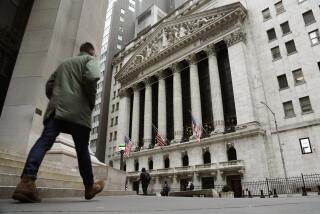Economy Stays Sluggish in October : Factory Orders Drop 6%, Biggest Decline in 2 Years
- Share via
WASHINGTON — Factory orders for durable goods plunged 6% in October, the Commerce Department said Tuesday. It was the largest such drop in over two years and signals continued slow growth for the nation’s economy.
At the same time, the Labor Department reported another month of low inflation, as consumer prices rose a scant 0.2% in October. Energy costs have fallen at an annual rate of 22.7% since the beginning of the year, becoming the main factor in an inflation rate of only 1.5% over the last 12 months. Prices of gasoline, fuel oil and natural gas all were down 2% or more last month.
Taken together, economists noted, the two reports suggest an economy continuing on the same track it has sluggishly pursued for months: slow growth with little or no risk that high inflation will return anytime soon.
Snapshot of Economy
Indeed, a third report issued Tuesday showed that actual factory shipments of durable goods increased 0.7% in October. It was the fourth time in five months that that economic indicator had risen, but most of those increases were less than a full percentage point--an almost perfect snapshot of an economy moving forward at half speed.
A separate measure of inflation--one used to calculate wage and benefits increases linked to consumer prices--increased by only 0.1% for the month and only 1.2% since October a year ago. Before seasonal adjustment, the consumer price index, from which the Labor Department computes monthly price changes, rose by 0.3%. That index is developed from a base of 100 in 1967, meaning that a selected cross section of consumer goods costing $100 in 1967 now costs $330.50.
Also on an unadjusted basis, consumer prices in the Los Angeles-Anaheim-Long Beach metropolitan area increased a noticeably steeper 0.5% for the month. In greater Los Angeles, inflation measured by the consumer price index has run at 3.1% over the last 12 months, compared to 1.5% nationwide.
Upbeat White House
Despite the sharp decline in orders for durable goods--the biggest drop since a 6.8% decline in April, 1984--White House spokesman Larry Speakes gave an upbeat assessment of the day’s statistics. “The American economy is gathering steam,” he said. “Today’s news on the inflation front assures us that the new growth will not be accompanied by a return of the devastating inflation that preceded the President’s tenure in office.”
In a separate statement, Commerce Secretary Malcolm Baldrige noted that an unusually steep 43% decline in the volatile category of defense orders accounted for more than half of the decline. “Excluding defense,” he said, “orders declined 2.7%, giving up some of September’s strong 4.6% increase.”
The huge decline in defense orders was far more than expected in the markets, where analysts were expecting an overall decline of 1.3% to 3% in durable goods. More significant perhaps was the fact that, in the key category of non-defense capital goods--including machinery, communications equipment, aircraft and other non-defense transportation equipment--orders were off 7.4%, almost exactly offsetting a strong 7.2% gain in September.
Another Report Due
“The downer is that people began to see the light at the end of the tunnel with September’s report, but this shows that we are still back where we were with respect to manufacturing industries,” said economist Douglas Handler of Wharton Econometrics. He noted that today’s report on merchandise trade should give the next hint of whether September’s glimmer of improvement had any validity at all.
The inflation report, he added, was much the same as in recent months, with energy down slightly more than expected, food up only 0.3% after a series of drought-caused increases, and with everything else moving at a basic rate of between 3% and 4%.
“With the two reports combined,” he said, there is no reason to expect any surge in inflation in the near future--nowhere near enough increase for the (Federal Reserve Board) to take alarm.” In recent months, markets have been easily spooked by any suggestion that the Fed, anticipating inflation, might begin to tighten up the money supply, thereby raising interest rates.
‘Same Old Story’
Another private economist, Cynthia Latta of Data Resources Inc., tended to downgrade the significance of both reports. The inflation statistics were “rather boring, the same old story: Energy bailed us out and will continue to help us even if it stops falling.”
As to the plunge in orders for goods, Latta counseled paying more attention to the 0.7% increase in actual shipments. “Orders are not money on the line, orders are only hopes for the future, and they can be canceled. But shipments reflect real production.” The small increase in that category, she said, “is consistent with the slow economic growth, without recession, we’ve been having.”
More to Read
Inside the business of entertainment
The Wide Shot brings you news, analysis and insights on everything from streaming wars to production — and what it all means for the future.
You may occasionally receive promotional content from the Los Angeles Times.










